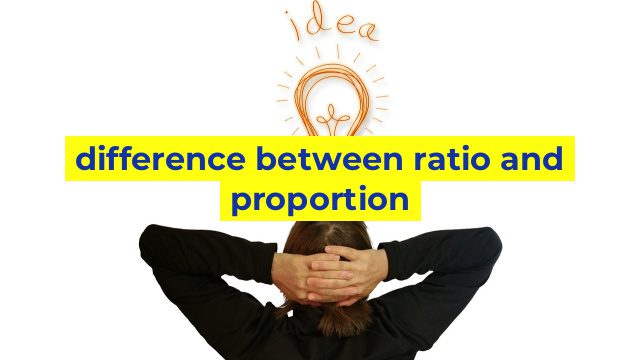Understanding the Difference Between Ratio and Proportion
Understanding the concepts of ratio and proportion is essential in various fields such as finance, mathematics, science, and design. Although these terms are often used interchangeably, they have different meanings and uses. In this article, we will look at the difference between ratio and proportion.
What is a Ratio?
A ratio represents the relationship between two or more quantities. It expresses the comparison of one quantity to another. It is commonly represented in the form a:b, where a and b are the two quantities being compared. Ratios can be expressed in different ways such as fractions, decimals or percentages.
For example, a ratio of 2:3 represents the comparison of two units of something to three units of something else. It can also be expressed as 0.67 or 67%.
Ratios are used in various fields such as finance, where it is used to compare financial data such as profit margins, liquidity ratios, and debt-equity ratios. In mathematics, it is used to simplify fractions, solve proportions, and perform operations such as addition, subtraction, multiplication, and division.
What is a Proportion?
A proportion is used to compare the ratio of two or more quantities. It expresses that two ratios are equal. It is written in the form of a:b = c:d or a/b = c/d. It means that the ratio of two quantities is equal to the ratio of other two quantities.
For example, if the ratio of boys to girls in a school is 3:4, we can use proportions to find out how many boys and girls are in the school. If there are 300 boys, then we can assume there are 400 girls in the same school.
Proportions are used in various fields such as physics, chemistry or engineering where it is used to solve problems related to speeds, distances, or fundamental constants.
The Key Differences between Ratio and Proportion
The main difference between ratio and proportion is that ratios compare two or more quantities, while proportions compare the ration of two or more quantities.
Another significant difference is that ratios are expressed as a comparison of two quantities using numbers and symbols, while proportions are expressed as a comparison of two or more ratios using equations.
In conclusion, ratios and proportions are used in various fields to compare and analyze different quantities. Knowing the difference between the two can help us use them correctly and efficiently.
Table difference between ratio and proportion
| Aspect | Ratio | Proportion |
|---|---|---|
| Definition | A relationship between two quantities indicating how many times the first quantity is contained within the second quantity | A statement that two or more ratios are equal in value |
| Representation | Usually represented in the form of “a/b” or “a:b” | Usually represented in the form of “a:b :: c:d” or “a/b = c/d” |
| Example | If a recipe calls for a 2:1 ratio of flour to sugar, then for every 2 cups of flour, 1 cup of sugar should be used | If 4 red M&Ms and 6 green M&Ms are in a bag, and there are 2 red M&Ms and 3 green M&Ms in another bag, then the ratio of red M&Ms to green M&Ms is 4:6 and 2:3, respectively. Thus, it can be concluded that the proportion of red M&Ms to green M&Ms in both bags is equal |
| Application | Used in various mathematical calculations such as determining the speed, distance, time, and other factors in physics, engineering, and other sciences | Used in various mathematical and real-life situations such as solving problems related to sales taxes, discounts, and measurements |

